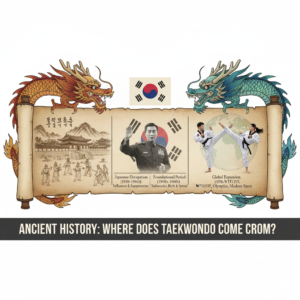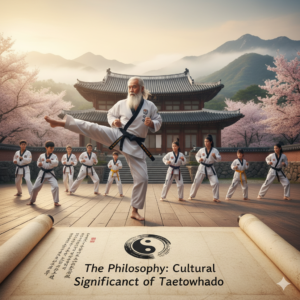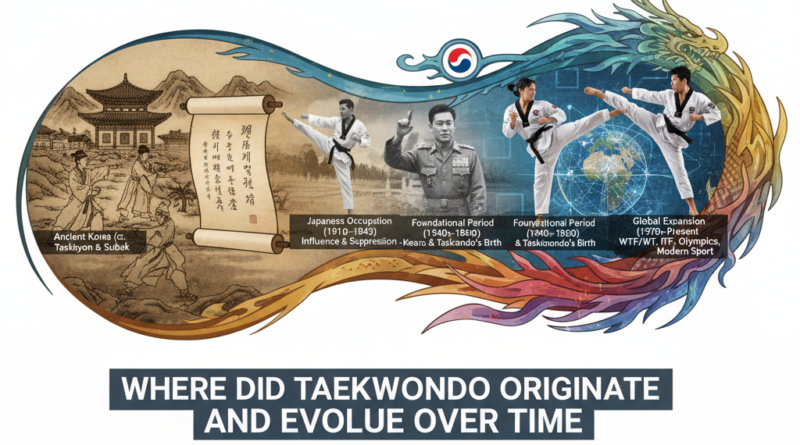Where Did Taekwondo Originate? The Complete History
If you’ve ever watched the graceful yet powerful kicks of a Taekwondo practitioner, you might have wondered: Where did Taekwondo originate? This dynamic martial art has captured the imagination of millions worldwide, but its roots run deep into the Korean Peninsula’s rich history.
The Direct Answer: Taekwondo’s Origin Country
Taekwondo originated in Korea, specifically on the Korean Peninsula. The modern form of this martial art was developed during the 1940s and 1950s, with the name officially adopted in 1955. While the contemporary version is relatively young, the ancient history of Taekwondo stretches back over 2,000 years, making it one of the most historically significant martial arts in existence.
Understanding What Taekwondo Means
It is worth first knowing what Taekwondo means before going into the history of Taekwondo. The taekwondo etymology is based on three Korean words, which are Tae (foot), Kwon (fist), and Do (way or path). The Taekwondo Korean name, when combined, means the way of the foot and fist, which perfectly describes the meaning of this martial art that is based on striking.
Ancient History: Where Does Taekwondo Come From?
The Three Kingdoms Period

The classic Taekwondo history evolved in the Three Kingdoms Period of history in Korea that existed between 57 BC and 668 AD. It was in this period that the Koguryo Dynasty and the Silla Dynasty evolved advanced martial arts, which would later affect contemporary Taekwondo.
This development was especially important among the elite Hwarang warriors of the Silla Dynasty. These young nobles were schooled in some war strategies and philosophical disciplines, which formed a basis that focused on both physical skills and the development of morality. This two-fold emphasis on physical and spiritual development is still the key to the cultural importance of Taekwondo in the modern world.
Early Korean Martial Arts
Subak and Taekyon were the ancient forms of martial arts practiced by ancient Koreans long before the date of establishment of Taekwondo in 1955. These native combat systems are thousands of years old and have much in common with current Taekwondo. Especially the focus on efficient kicking skills.
These roots have the backing of archaeology. Murals found in royal tombs in Goguryeo, between 37 BC and 668 AD, show the figures engaged in martial arts moves, which are closely similar to those of Taekwondo performed today. These historical artifacts are concrete evidence of the way did Taekwondo began within the Korean culture.
Modern Development: When Was Taekwondo Created?
Post-World War II Revival
The modern history of the Taekwondo invention starts in the year 1945, when Korea was set free from the Japanese occupation. The culture of the Koreans, such as martial arts, was suppressed during the colonial period between 1910 and 1945. But with liberation, national pride and the need to recover Korean identity were high.
The 1940s and 1950s: Birth of Modern Taekwondo
The taekwondo 1940s 1950s era was the systematic growth of the martial art that we presently know. After liberation, Korean martial artists who had served in foreign countries came home and shared information about different fighting systems. Kwans were founded on the nine original schools of martial arts, with a minor approach and technique in each.
Initially taught in these schools were variations that were influenced by the Japanese karate as well as the Chinese martial arts. Though over time, more traditional Korean elements were introduced, especially the high, powerful kicks that make Taekwondo unique among other martial arts.
Who Invented Taekwondo?
Although numerous individuals contributed to its development, General Choi Hong Hi is attributed to being one of the major founders. He was instrumental in uniting the different kwans and harmonizing techniques. Taekwondo is a martial art that is unique to the Koreans, and in 1955, the name Taekwondo was adopted by a committee of masters, historians, and government officials and the martial art became officially recognized.
There are other key personalities such as Nam Tae Hi, Han Cha Kyo, Lee Won Kuk, Yoon Byung-In, and Hwang Kee. These masters were also able to work on the technical curriculum and philosophical system that makes Taekwondo what it is today.
The Philosophy: Cultural Significance of Taekwondo

The taekwondo philosophy extends far beyond physical combat. Rooted in Korean traditions, it incorporates Confucian values of respect and hierarchy. Buddhist principles of self-discipline and compassion, and Taoist concepts of harmony and balance.
The five tenets of Taekwondo reflect this philosophical depth:
- Courtesy (Ye Ui): Showing respect to instructors, fellow students, and opponents
- Integrity (Yom Chi): Being honest and maintaining moral principles
- Perseverance (In Nae): Continuing despite difficulties and setbacks
- Self-Control (Guk Gi): Maintaining composure in all situations
- Indomitable Spirit (Baekjul Boolgool): Facing challenges with courage and determination
These principles demonstrate why Taekwondo is not merely a fighting system but a comprehensive way of life, emphasizing character development alongside physical training.
Organizational Split and Global Expansion
The Formation of Two Major Bodies
In 1966, General Choi Hong Hi established the International Taekwon-Do Federation (ITF) that focused on traditional methods and patterns. Nevertheless, political differences gave rise to the World Taekwondo Federation (since then also called World Taekwondo or WT) in 1973. It specializes in sports competition.
This division brought out two different styles that had varying methods, shapes, and philosophies. Even though they both have a common descent to the same Korean roots.
Taekwondo Becomes a Global Phenomenon
Taekwondo started in the Korean Peninsula, but has since been exported to more than 200 countries. The martial art was demonstrated as an Olympic event in 1988, and it became a full Olympic event in 2000. Ensuring that the martial art remains a highly practiced martial art in the world.
The Kukkiwon, also known as the World Taekwondo Headquarters in Seoul, is the main organization of WT-style Taekwondo. Which sets standards and issues certifications of the dan (black belt) rank that is recognized internationally.
Archaeological Evidence and Historical Records
The ancient history documentation includes several important sources:
- Goguryeo tomb murals: Depicting martial arts techniques from the 5th century
- Samguk Sagi: The History of Three Kingdoms, chronicling early Korean martial practices
- Samguk Yusa: Memorabilia of the Three Kingdoms, providing additional historical context
- Muye Dobo Tongji: A comprehensive martial arts manual from 1790
These records validate the deep historical roots of Korean martial arts. Though scholars continue to debate the exact connections between ancient practices and modern Taekwondo.
Distinguishing Features: What Makes Taekwondo Unique?

While Taekwondo shares some similarities with other Asian martial arts like Japanese Karate and Chinese Kung Fu, several characteristics make it distinctly Korean:</span></span>
- Emphasis on kicking techniques: Taekwondo features more kicks, particularly high and spinning kicks, than most other martial arts
- Dynamic movement: Fast-paced, athletic techniques that showcase agility and flexibility
- Sport orientation: Strong focus on Olympic-style competition alongside traditional self-defense
- Philosophical integration: Deep connection to Korean cultural values and national identity
Taekwondo Today: A Living Korean Legacy
When we learn the origin of Taekwondo,. We get to appreciate the importance of Taekwondo as more than a martial art but a source of Korean cultural heritage, persistence, and creativity.</span> Taekwondo represents the Korean spirit.</span> Whether it is a warrior of ancient times striking in the defense of their kingdoms. A modern Taekwondo athlete fighting in the global arena.
The martial art has evolved while preserving its fundamental nature. Now, Taekwondo has a chance to offer athletes with disabilities. Taekwondo has been understood as having cultural significance by UNESCO. Training schools or dojangs can be found in virtually all countries. They educate millions of students about the physical methods and philosophical values that were introduced in the Korean Peninsula several centuries ago.</span></span>
As a practitioner, as a parent who thinks of taking your child to martial arts, or as a curious person about the history of martial arts, knowing the origin story of Taekwondo will add to your knowledge of this amazing field.</span> It is a miracle that cultural traditions can change, survive.</span> Evolve even across borders and still preserve their main identity and values.



